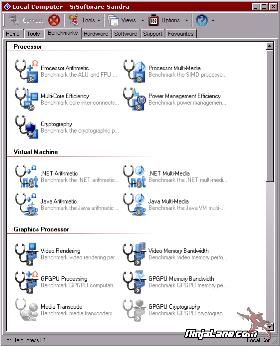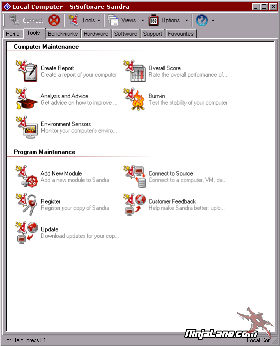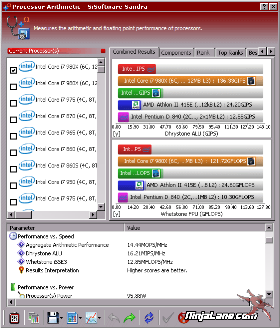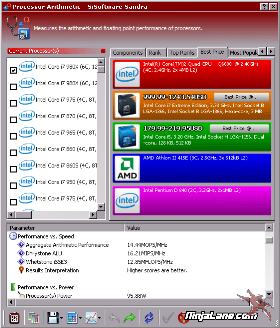After careful consideration I have decided to transfer all hardware review activities to a new domain. I purchased Hardwareasylum.com in 2012 and have been working hard to build a new and improved Ninjalane on that domain. If you are reading this you have reached one of the archived articles, news, projects and/or reviews that were left behind during the site migration.
Please update your bookmarks and be sure to visit the new and improved Ninjalane at Hardwareasylum.com
SiSoftware Sandra 2011 Benchmark Review
Author: Dennis Garcia
Published: Monday, November 08, 2010
Sandra 2011 Changes
Below are the changes between versions 2010 to 2011.
Geometric mean for aggregate scores: This corresponds to how combined scores are calculated and is designed to fix the score imbalance when comparing components that don't share the same features or are not scored using the same data metric.
Measure each operation and compute the score range (min-max) and not just take the average: This actually translates into an additional meteric that is displayed along with the typical scores we normally see. The idea here is to add depth to the average score by exposing if it was determined by an extremely high peak or simply a prolonged list of closely matched values.
New Benchmark! Media Transcode: Media transcoding is a great way to determine system speed beyond memory and CPU interaction. Consider that most video cameras save videos in a proprietary format and have to be converted before you can view them on your PC. This benchmark simulates this common task and is a great way to determine total system speed.
Memory Bandwidth, Cache & Memory Benchmarks: AVX/FMA for future Intel (Sandy Bridge) and AMD CPUs: This is basically an upgrade to how the memory tests are performed and fixes some issues that were reported in previous versions. Since Windows did a pretty poor job at allocating threads SiSoft decided to "roll their own" to obtain consistent and repeatable results.
Multi Core Efficiency Benchmark, update test block size: This is one benchmark we have not used much since it is specific to testing CPUs. The end users will find this beneficial when looking for the most efficient processor and how L3 cache affects overall performance.
Power Management Efficiency Benchmark, Updated ALU/MIPS and FPU/MFLOPS work-load sizes: I'm going to quote SiSoft on this one as they say it best.
Up to 256-thread support across all benchmarks: One of the great things about 64-bit OS's is higher memory allocations and the ability to handle more work at any given time. Sandra now supports up to 256 threads across all of the benchmarks despite only testing up to 80-threads at one time.
Measure each operation and compute the score range (min-max) and not just take the average: This actually translates into an additional meteric that is displayed along with the typical scores we normally see. The idea here is to add depth to the average score by exposing if it was determined by an extremely high peak or simply a prolonged list of closely matched values.
New Benchmark! Media Transcode: Media transcoding is a great way to determine system speed beyond memory and CPU interaction. Consider that most video cameras save videos in a proprietary format and have to be converted before you can view them on your PC. This benchmark simulates this common task and is a great way to determine total system speed.
Memory Bandwidth, Cache & Memory Benchmarks: AVX/FMA for future Intel (Sandy Bridge) and AMD CPUs: This is basically an upgrade to how the memory tests are performed and fixes some issues that were reported in previous versions. Since Windows did a pretty poor job at allocating threads SiSoft decided to "roll their own" to obtain consistent and repeatable results.
Multi Core Efficiency Benchmark, update test block size: This is one benchmark we have not used much since it is specific to testing CPUs. The end users will find this beneficial when looking for the most efficient processor and how L3 cache affects overall performance.
Power Management Efficiency Benchmark, Updated ALU/MIPS and FPU/MFLOPS work-load sizes: I'm going to quote SiSoft on this one as they say it best.
"While few of you use this benchmark we feel is very much understated. Seeing how the frequency/voltage/current varies with various loads is pretty useful especially when undervolting/underclocking systems for better power efficiency."
Up to 256-thread support across all benchmarks: One of the great things about 64-bit OS's is higher memory allocations and the ability to handle more work at any given time. Sandra now supports up to 256 threads across all of the benchmarks despite only testing up to 80-threads at one time.
Ranker Engine more useful: This might be one of the coolest features that were released in Sandra version 2010. At first we thought the ranker was something similar to HWBot or the Futuremark ORB but instead it turned out to be more of a locker for your benchmark runs. That way you could look back on past submissions and see how much faster, or slower, your system has gotten. Teams also have access to these numbers so everyone in your overclocking circle can compare notes.
Price Engine: Personally I didn't find the price engine all that entertaining but the value to the end user is unlike anything else. Consider this; you are trying to determine if upgrading to a Core i5 is worth it based on your current system running a Q6600. All of the numbers say yes but is the additional cost worth the jump in performance?
The price engine will tell you this, and the best part is that as prices change so will the ranking numbers.
Price Engine: Personally I didn't find the price engine all that entertaining but the value to the end user is unlike anything else. Consider this; you are trying to determine if upgrading to a Core i5 is worth it based on your current system running a Q6600. All of the numbers say yes but is the additional cost worth the jump in performance?
The price engine will tell you this, and the best part is that as prices change so will the ranking numbers.





